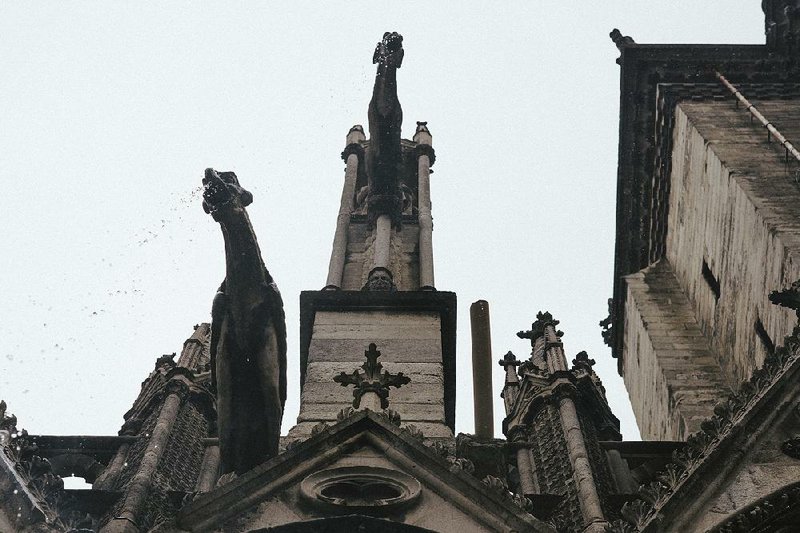PARIS -- Broken gargoyles and fallen balustrades replaced by plastic pipes and wooden planks. Flying buttresses darkened by pollution and eroded by rainwater. Pinnacles propped up by beams and held together with straps.
Little of that deterioration is immediately visible to the millions of awe-struck tourists who visit the Notre Dame Cathedral in Paris every year, many of them too busy admiring the intricately sculpted front to notice the wear and tear.
But on a recent afternoon, Andre Finot, the cathedral's spokesman, pointed out the decay. One patch of limestone crumbled at a finger's touch.
"Everywhere the stone is eroded, and the more the wind blows, the more all of these little pieces keep falling," said Finot, gingerly stepping over fallen chunks of stone on the cathedral's rooftop walkway. "It's spinning out of control everywhere."
This is not the first time, nor will it be the last, that the cathedral, a jewel of medieval Gothic architecture, has required an extensive makeover.
But experts say Notre Dame, although not at risk of sudden collapse, has reached a tipping point -- and an expensive one at that.
To foot the bill, an estimated 150 million euros, or nearly $180 million, they are hoping to capitalize not only on the architectural patriotism of the French, but also on the francophilia of U.S. donors.
"There is a real need for urgent restoration work," said Michel Picaud, who heads the newly created Friends of Notre Dame de Paris foundation, which aims to raise money in the United States.
Notre Dame de Paris, which sits at the heart of the capital, is on many people's to-do lists, including the likes of Melania Trump and Beyonce. It is part of a "sentimental bond" between France and the United States, one forged through wartime alliances, common values and a reciprocal fascination for each other's culture, Picaud argued.
Built in the 12th and 13th centuries, Notre Dame received one of its most significant overhauls between 1844 and 1864, when the architects Jean-Baptiste-Antoine Lassus and Eugene Emmanuel Viollet-le-Duc redid the spire and the flying buttresses and added several architectural tweaks.
That restoration followed decades of neglect and partial damage at the hands of French revolutionaries, and was prompted in part by Victor Hugo's publication of his 1831 novel Notre-Dame of Paris, which shone a light on the building's decrepit state.
"Assuredly, the Cathedral of Notre-Dame at Paris is, to this day, a majestic and sublime edifice," Hugo wrote in the novel. "But noble as it has remained while growing old, one cannot but regret, cannot but feel indignant at the innumerable degradations and mutilations inflicted on the venerable pile, both by the action of time and the hand of man."
The words ring true today. "Here we are 150 years or so after he wrote that, the call to arms for the Notre Dame of 150 years ago, and it works again now," said Andrew Tallon, an associate professor of architecture and art history at Vassar College.
Notre Dame, he said, now faces a "very exciting, if not scary, situation, where it needs all its help."
Not that most tourists could tell, as they stood on a recent afternoon in snaking lines to visit the cathedral, snapping selfies and peering up at its two towers.
About 13 million people visit Notre Dame Cathedral every year -- roughly 30,000 a day.
"It doesn't look like it needs work," said Liz Bronze, a 25-year-old visiting from London with a friend. "The building looks beautiful like this."
At first glance, it does. The stained-glass windows of the nave were replaced in the 1960s to a colorful and vibrant result.
The front facade was left a gleaming white in the 2000s after a decade of cleaning pollution-coated stone. Several bells were replaced in 2013, with great fanfare, ahead of the cathedral's 850th anniversary.
"When you look at it from the front, there is no problem," said Picaud, the head of the foundation. "But when you go behind the scenes, that's when things start to go downhill."
Water regularly seeps through cracks in the lead-covered spire, weakening its wooden frame. Rain, some of it acid, is slowly eroding the flying buttresses and their decorative pinnacles, built with delicate limestone.
Gargoyles have fallen and have been replaced with PVC pipes. On a small lawn at the back of the cathedral, masonry that has broken away or that was taken down as a precautionary measure over the years has been neatly piled up.
Philippe Villeneuve, the chief architect in charge of the cathedral's renovation, explained that Notre Dame is tricky to restore because in Gothic architecture "the elements all have dynamic structural roles."
Pinnacles, for instance, help anchor and stabilize the flying buttresses, which take on the weight of the cathedral.
The twisted and mocking faces of the gargoyles serve as much to decorate as they do to funnel rainwater.
"If you remove one of those elements, there is a disequilibrium somewhere," Villeneuve said. "The whole building isn't going to crumble just because you lose three pinnacles, but it will unbalance it."
The Friends of Notre Dame foundation estimates that it needs nearly $40 million for urgent repairs, and it hopes to raise more than $110 million in the next decade for complete renovations.
The French state, which owns the cathedral, already devotes up to 2 million euros a year in upkeep, or about $2.4 million. It recently pledged to double that amount for the next 10 years, according to Picaud.
The cathedral's staff is also mounting an effort to raise private funds, especially in the United States.
That effort was fostered by an existing relationship with Vassar College, including Tallon, who in 2013 was a co-writer of a book on Notre Dame de Paris that became the basis for a continuing exhibit in the cathedral's ambulatory.
SundayMonday on 10/01/2017

